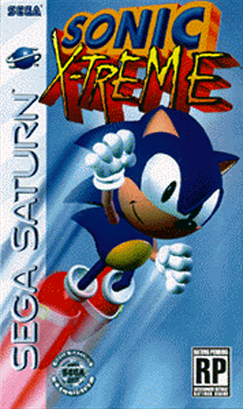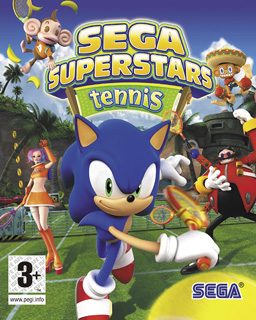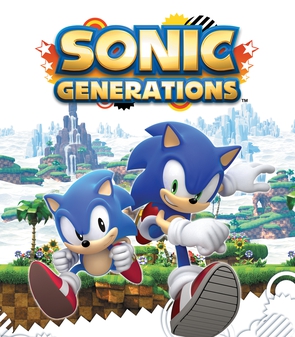
Nights into Dreams is a 1996 action game developed by Sonic Team and published by Sega for the Sega Saturn. The story follows the teenagers Elliot Edwards and Claris Sinclair, who enter Nightopia, a dream world where all dreams take place. With the help of Nights, an exiled "Nightmaren", they begin a journey to stop the evil ruler Wizeman from destroying Nightopia and consequently the real world. Players control Nights flying through Elliot and Claris's dreams to gather enough energy to defeat Wizeman and save Nightopia. The game is presented in 3D and imposes time limits on every level, in which the player must accumulate points to proceed.
Sonic Team is a video game developer owned by the Japanese video game company Sega as part of its Sega CS Research and Development No. 2 division. Sonic Team is best known for the long-running Sonic the Hedgehog series and games such as Nights into Dreams and Phantasy Star Online.

Sonic Adventure is a 1998 platform game developed by Sonic Team and published by Sega for the Dreamcast. It was the first main Sonic the Hedgehog game to feature 3D gameplay. It follows Sonic the Hedgehog, Miles "Tails" Prower, Knuckles the Echidna, Amy Rose, Big the Cat, and E-102 Gamma in their quests to collect the Chaos Emeralds and stop Doctor Robotnik from unleashing Chaos, an ancient evil. Controlling one of the six characters—each with their own abilities—players complete levels to progress the story. Sonic Adventure retains many elements from prior Sonic games, such as power-ups and the ring-based health system. Players can play minigames such as racing and interact with Chao, a virtual pet.

Sonic Heroes is a 2003 platform game developed by Sonic Team USA and published by Sega as part of the Sonic the Hedgehog series. The player races a team of series characters through levels to amass rings, defeat robots, and collect the seven Chaos Emeralds needed to defeat Doctor Eggman. Within each level, the player switches between the team's three characters, who each have unique abilities, to overcome obstacles. Sonic Heroes abandons the action-adventure and exploration-based gameplay of its predecessors Sonic Adventure (1998) and Sonic Adventure 2 (2001) and instead returns to the linear style of Sega Genesis-era Sonic games.

Sonic X-treme was a platform game developed by Sega Technical Institute from 1994 until its cancellation in 1996. It was planned as the first fully 3D Sonic the Hedgehog game, taking Sonic into the 3D era of video games, and the first original Sonic game for the Sega Saturn. The storyline followed Sonic on his journey to stop Dr. Robotnik from stealing six magic rings from Tiara Boobowski and her father. X-treme featured open levels rotating around a fixed center of gravity and, like previous Sonic games, featured collectible rings and fast-paced gameplay.

Sonic the Hedgehog is a Japanese video game series and media franchise created by Yuji Naka, Naoto Ohshima, and Hirokazu Yasuhara for Sega. The franchise follows Sonic, an anthropomorphic blue hedgehog who battles the evil Doctor Eggman, a mad scientist. The main Sonic the Hedgehog games are platformers mostly developed by Sonic Team; other games, developed by various studios, include spin-offs in the racing, fighting, party and sports genres. The franchise also incorporates printed media, animations, feature films, and merchandise.

Sonic and the Secret Rings is a 2007 platform video game developed by Sonic Team and published by Sega for the Wii. A spin-off from the Sonic the Hedgehog series, it is the first title in the franchise for the system, and follows Sonic the Hedgehog's quest to stop an evil genie named the Erazor Djinn. In addition to the basic platforming gameplay of previous Sonic titles, Secret Rings uses a system of experience points and levels, as well as special moves that are unlocked via leveling up.

Sonic Riders: Zero Gravity is a hoverboard racing video game developed by Sonic Team and published by Sega for the PlayStation 2 and Wii. It is the fifth pure racing game in the Sonic the Hedgehog series, and the second entry in the Sonic Riders trilogy, a spin-off of the main series.
Prope Ltd. is a Japanese video game development studio founded by Sonic Team head Yuji Naka, along with 10 other former Sonic Team staff.
Takashi Iizuka is a Japanese video game director, producer, designer and screenwriter. Since 2008, Iizuka has been the vice president of product development for the Sonic the Hedgehog series at Sega, as well as the head of Sonic Team although he has been working on games in the Sonic series since 1994.

Mario & Sonic at the Olympic Games is a 2007 crossover sports and party game developed by the Sega Sports R&D Department. It is the first installment on the Mario & Sonic series. It was published by Nintendo in Japan and by Sega in other regions, and released on the Wii in November 2007 and the Nintendo DS handheld in January 2008. The first official video game of the 2008 Summer Olympic Games, it is licensed by the International Olympic Committee (IOC) through exclusive licensee International Sports Multimedia (ISM), and is the first official crossover game to feature characters from both the Mario and Sonic the Hedgehog series.

Sega Superstars Tennis is a sports video game developed by Sumo Digital and published by Sega. It is the second title in the Sega All-Stars series, preceded by Sega Superstars (2005), and crosses over characters, locations, and soundtracks from several Sega franchises, including Sonic the Hedgehog, Space Channel 5, and Super Monkey Ball.

Sonic Unleashed is a 2008 platform video game in the Sonic the Hedgehog series. The story follows Sonic as he attempts to restore the world after his nemesis Doctor Eggman shatters it with a powerful laser to unleash Dark Gaia, an ancient evil, while dealing with having become a "Werehog", a werewolf-like transformation, which he gains after coming into contact with the energy of Dark Gaia. Gameplay features two distinct styles, with each being played either during daytime or nighttime. Daytime stages incorporate Sonic's traditional platforming and trademark speed, with a combination of behind-the-back third-person viewpoints and 2D side-scroller platforming; gameplay seamlessly transitions between these two views. Night-time levels see Sonic transform into the Werehog; gameplay slows down to accommodate greater platform play, and involves combat against waves of enemies using the Werehog's brute strength.

Sonic and the Black Knight is a 2009 platform video game developed by Sonic Team and published by Sega as part of the Sonic the Hedgehog series for the Nintendo Wii. It is the second and final entry in the Sonic Storybook series, following Sonic and the Secret Rings (2007), and involves Sonic being transported to the story of King Arthur by wizard Merlina, under the pretense that they are attempting to stop a corrupted Arthur ; however, it is later revealed that there was no corruption and that Merlina had secretly wanted to become the Dark Queen to prevent the legend's fate from occurring. Gameplay involves controlling Sonic around with the Wii Remote's motion-sensing functionality, particularly swinging around the sword to attack enemies and to move forward.

Mario & Sonic at the Olympic Winter Games is a 2009 sports and party game developed by Sega. Like its predecessor, it was published by Nintendo for Japan and Korea and by Sega in the Western world. The game is officially licensed by the International Olympic Committee (IOC) through exclusive license International Sports Multimedia. The game is the third official crossover title to feature characters from both Mario and Sonic's respective universes, the first and second being the game's predecessor Mario & Sonic at the Olympic Games and Super Smash Bros. Brawl respectively. It was released on the Wii and the Nintendo DS in October 2009, and is the first official video game of the 2010 Winter Olympic Games.

Sonic the Hedgehog 4: Episode I is a 2010 platform game developed by Dimps, with assistance from Sonic Team, and published by Sega. It is a sequel to Sonic & Knuckles (1994), following Sonic as he sets out to stop a returning Doctor Eggman. Like the Sonic the Hedgehog games released for the Sega Genesis, Episode I features side-scrolling gameplay, with movement restricted to a 2D plane. The player races through levels collecting rings while rolling into a ball to attack enemies. The game also features special stages in which the player collects Chaos Emeralds and online leaderboards comparing level completion times and high scores.

Sonic Colors is a 2010 platform game published by Sega. It follows Sonic's quest to stop his nemesis Doctor Eggman from enslaving an alien race and taking over the world. The gameplay is similar to prior Sonic games, with players collecting rings and defeating enemies; the camera perspective often switches from third-person to side-scrolling perspectives. The game also introduces Wisps, power-ups the player can use to increase attack power and reach new areas.

Mario & Sonic at the London 2012 Olympic Games is a 2011 crossover sports and party game developed by Sega Japan. It was published by Nintendo in Japan and Korea and by Sega elsewhere. As the third instalment in the Mario & Sonic series, it was released on the Wii on 15 November 2011 in North America, 18 November 2011 in Europe, and 26 December 2011 in Japan. It was also released for the Nintendo 3DS in February 2012. Mario & Sonic is the official video game of the 2012 Summer Olympics and is licensed by the International Olympic Committee through exclusive licensee International Sports Multimedia. The game is the only Wii title to come in a yellow keep case.

Sonic Generations is a 2011 platform game developed by Sonic Team and published by Sega for the PlayStation 3, Xbox 360, Windows, and Nintendo 3DS. Produced in commemoration of the 20th anniversary of the Sonic the Hedgehog series, the game follows Sonic and his sidekick Tails as they form an alliance with their modern selves. It features two gameplay styles: "Classic", which plays from a side-scrolling perspective like that of the original Sega Genesis Sonic games, and "Modern", 3D levels similar to those in Sonic Unleashed (2008) and Sonic Colors (2010).

Sonic Lost World is a 2013 platform game developed by Sonic Team. It is part of the Sonic the Hedgehog series, and was released in October 2013 for the Wii U and Nintendo 3DS in PAL regions by Nintendo and by Sega in North America and Japan. A port of the Wii U version for Windows was later released in November 2015.

















